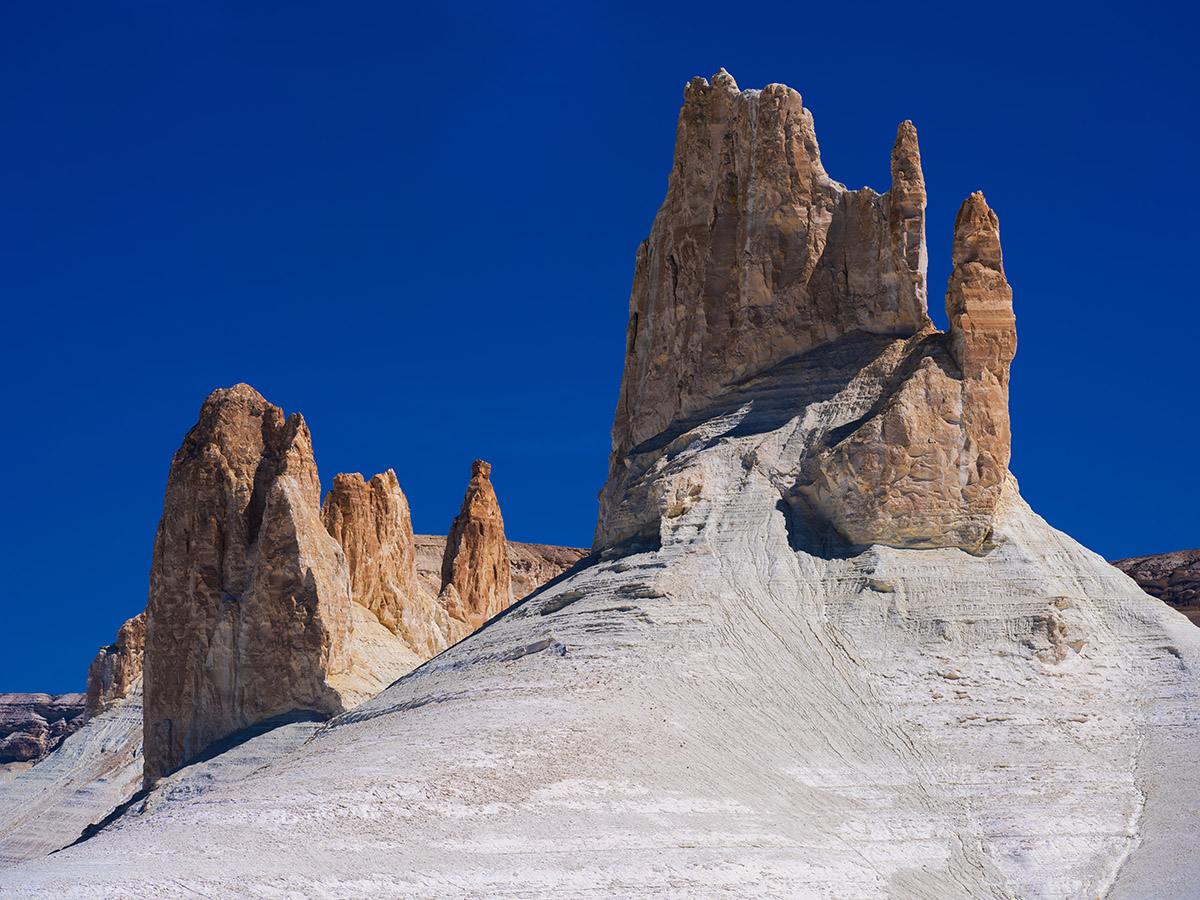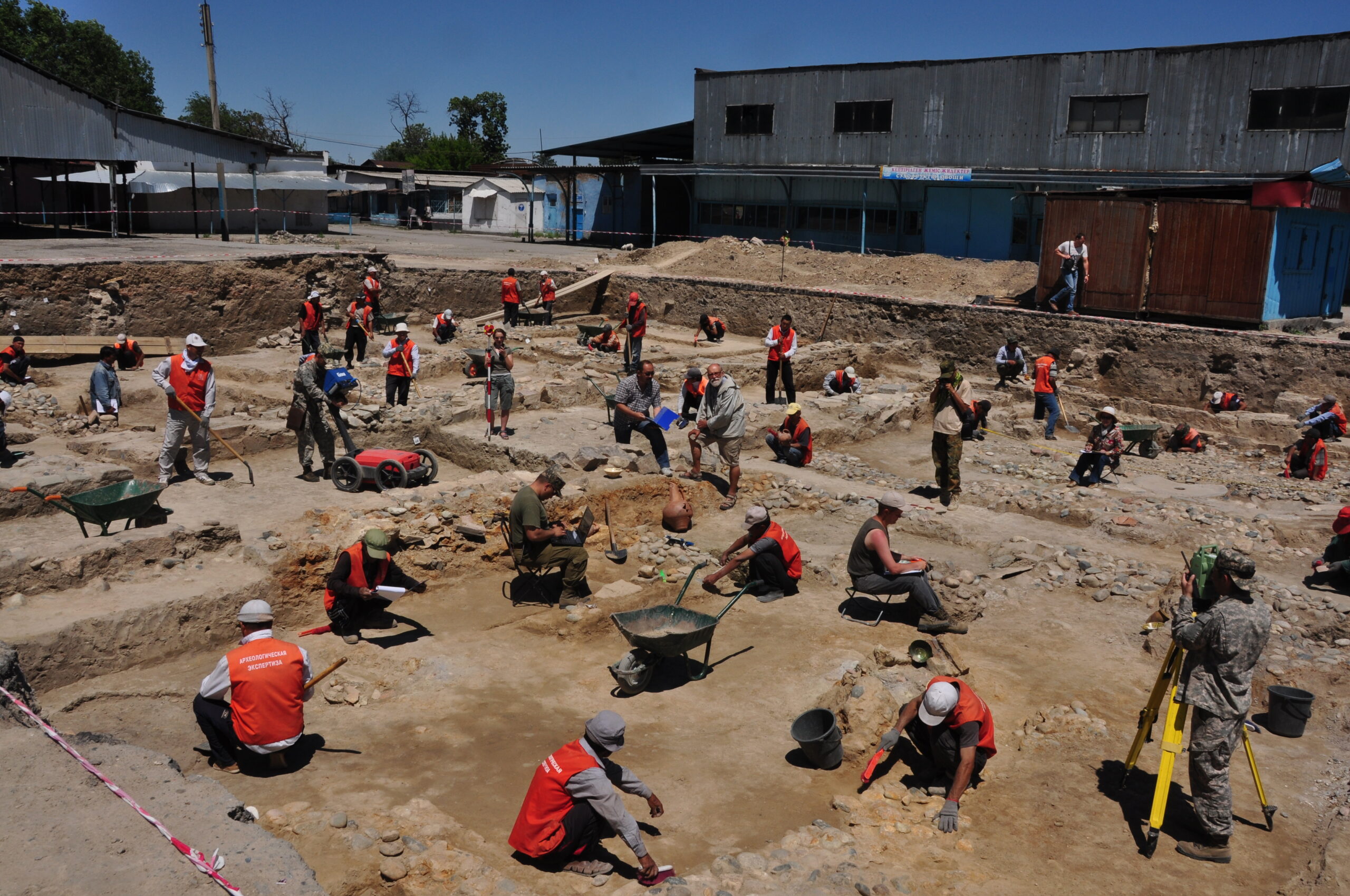ASTANA – With millenia of human and natural history coupled with the ninth largest territory in the world, Kazakhstan holds significant potential for unique nominations for the United Nations Educational, Scientific and Cultural Organization (UNESCO) World Heritage List due to their value to humanity, said Dmitriy Voyakin, an expert in archaeology and monument preservation in an interview with The Astana Times.

Otrar. Friday mosque. 14-15 c AD. Aerophoto. Photo supplied by Dmitriy Voyakin.
Unique nominations
On the bottom of the ancient Tethys Ocean, overlooked by sand and clay hollows, desert of limestone sediments, ornamental rocks, and canyons, a monument to ancient history might be uncovered.
The Mangystau Region, with its Ustyurt plateau, necropolises with mausolea and kulpytas (tomb epitaphs), not to mention its underground rock mosques, offers a unique mix of cultural and natural heritage that might be worthy of addition to the UNESCO list.
“All this diversity can be presented as one property, perhaps the first in our region’s history and in our relationship with UNESCO, as a mixed heritage site encompassing both natural and cultural elements. It will be a unique experience for us and for our Central Asian region in general,” said Voyakin.

Bozzhyra tract in the Mangystau Region. Photo credit: Farkhat Kabdykhaiyrov.
Apart from the global recognition that such a nomination brings, it would be a crucial milestone in the developemnt of Kazakh science and the heritage management system, according to Voyakin.
“If Kazakhstan makes such a step, the most important thing here is not to boast or to show how good we are, no. Why is it important? Because we would be the first ones to raise this issue, which demonstrates the progress Kazakhstan has made over the years of its independence in the sphere of heritage management. We are talking about the most complex objects of nomination and we have the potential. Kazakhstan has the potential of human resources to prepare this nomination, the diplomatic potential that will allow us to bring this nomination to the point where it can be included in the World Heritage List for the first time, and I’m sure that we have the potential of then managing such a complex site,” he said.

Kok-Mardan. Otrar oasis. Aerophoto. Photo supplied by Dmitriy Voyakin.
Voyakin also expresses hope for including other serial transnational nominations, such as mosques and minarets (prayer call towers) of Central Asia or a nomination of petroglyphs of Central Asia. Those sites, not related to the Silk Road, could position Kazakhstan as a leader in launching new initiatives, according to Voyakin.
“Kazakhstan, as well as other Central Asian counries, is rich in petroglyphs. We already have experience of including one of the sites, the Tamgaly petroglyphs, on the list. There are dozens of other sites across the country. They can be included as individual nominations or as a series. If we talk about a series, then it is a vast region that includes our neighboring countries,” said Voyakin.
“Or another interesting nomination that has been discussed extensively is the Golden Mountains of Altai. This includes Altai and the magnificent Saka necropolises, such as the golden mounds in Berel. This nomination could involve neighboring countries as well,” he added.
Series of transnational nominations along the Silk Road
Regarding the projects Voyakin is currently working on, he noted a trend towards the involvement of multiple countries in preparing serial transnational nominations along the Silk Road.

Silk road map. Photo supplied by Dmitriy Voyakin.
“These nominations are among the most challenging, especially when they involve multiple countries or when a single site extends beyond the borders of one state and spans beyond a different historical periods. It is only through the collaborative efforts of many countries of a vast region that such nominations can be prepared and successfully included in the UNESCO World Heritage List,” said Voyakin.
Kazakhstan’s most recent serial transnational cultural nomination was the Silk Roads: The Routes Network of Chang’an Tian Shan Corridor – one of the major arteries of the historic Silk Road that opened up trade from China to the west. The transnational trading corridor covering 5,000 kilometers across China, Kazakhstan and the Kyrgyz Republic has been inscribed on the UNESCO World Heritage List in 2014.
“This project has enabled countries to achieve a breakthrough with UNESCO, overcoming many years of lack of positive results by inscribing 33 sites of historical and cultural heritage on the list simultaneously. Eight of these sites are located in Kazakhstan,” said Voyakin.
Archaeologists have uncovered a cluster of lost ancient cities in the Almaty and Zhambul regions. Kazakhstan’s eight sites included places as varied as the medieval city of Kayalyk which is considered the capital of the Karluk Kaganate, the center of iron, metal and glass production, the medieval Talgar site, and the sites of Saryesik-Atyrau desert.

Kayalyk. Friday mosque. 12-13 cc AD. Photo supplied by Dmitriy Voyakin.
Five sites on the territory of the Zhambul Region include Aktobe-Stepninskoye, Kostobe, Ornek, Kulan settlements and Akyrtas archaeological complex.
“Akyrtas is likely the most mysterious complex in Kazakhstan known to date. It is one of the few massive complexes 140 by 130 meters, entirely built of red stone. The walls reach two to three meters in height and are remarkably well-preserved. It is a magnificent and stunningly beautiful site,” said Voyakin.
To unearth the ancient history more accurately, Voyakin argues it is important to examine sites as part of a complex rather than individually.
“For example, if we talk about individual monuments like mosques, yes, it is evident that they were built in a conservative style: they have a mihrab part (a niche in mosque pointing to Mecca), they have minbar (pulpit) and minaret. But what’s interesting is not just the building itself, which structurally may follow the traditional design, but its positioning in relation to other buildings, that is, its landscape features,” said Voyakin.
The buildings they discovered at Kayalyk in the Almaty Region did not come from one religious background but included the 12-13 century mosque, Christian church, as well as Buddhist and Manichaean temples.
“This shows how tolerance and coexistence were observed in the region. (…) When we look at it in a complex, not just as one architectural building, the entire reading of this matter takes on a completely different dimension,” said Voyakin.
Fergana-Syrdarya corridor
Kazakhstan, in collaboration with other states, is now working on another nomination project. This initiative extends the Silk Road nomination and focuses on the Fergana-Syrdarya corridor, involving four countries: Kazakhstan, the Kyrgyz Republic, Tajikistan, and Uzbekistan. Up to 18 unique sites could potentially be included as part of a series on the UNESCO list.

Medieval Taraz. Archaeological excavations. Photo supplied by Dmitriy Voyakin.
As the north-west frontier of the Tian Shan, the Fergana-Syrdarya corridor is scattered with ancient observation towers, huge cemeteries or necropolises that have existed for centuries, oases, such as Otyrar and Zhetiasar oases, and the ancient Oguz cities.
“For example, within the Fergana-Syrdarya corridor in Kazakhstan, there’s a city that, I’m not afraid to say, holds the number one spot in the history of this vast region – it is the city of Ispijab. It stands as a significant historical and cultural site,” he said.
“Ispijab is located near Shymkent. The city remains largely unexplored because it is completely built-up by a modern city. So, at the moment, Ispijab holds immense potential for scientific investigation, similar to Taraz in its time. In its upper part, it is completely built-up, the upper layers are destroyed, but it is very deep, I think more than 10 meters of cultural layers. I am convinced that Kazakhstan, at some point in the future, will begin to study this site,” added Voyakin.
A lot more to discover
Kazakhstan’s extensive history, concealed beneath its urban landscapes, offers extensive opportunities for study.

Bottom of Aral Sea. Archaeological investigation. Photo supplied by Dmitriy Voyakin.
“In terms of percentage, what we have and know now is a drop in the ocean. Can you imagine thousands of years of active history that took place on the territory of Kazakhstan, the ninth country by its area? Every season, archaeologists open us a new page of history, but whatever their efforts, they can not give us a complete picture because there is a huge area to study,” said Voyakin.
The majority of Kazakhstan’s archaeological treasures have not been uncovered yet, primarily because they are buried beneath layers of soil and sediment.
“The peculiarity of archaeological monuments lies in two aspects: it is the hiddenness of sites, that is, they are often underground and unknown by virtue of their not-so-obvious signs and the fragility of sites, that is, these monuments are extremely easy to destroy and the work of a bulldozer for half a day can take down entire settlements that have been formed for millennia,” said Voyakin.
He said these unexplored objects should be protected by law and addressed at a legislative level.


